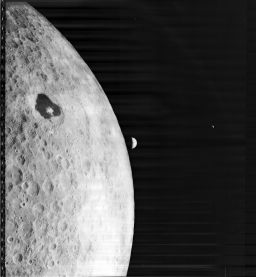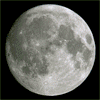Emily Lakdawalla • Nov 20, 2007
Seeing Earth rise and set from the Moon
A reader wrote me to comment that the press release associated with Kaguya's pictures of Earthrise and Earthset contained a couple of inaccuracies that have since been repeated around the Internet. The fist is that Apollo 8 was not the first mission to image an Earthrise over the Moon -- the first was Lunar Orbiter 1 in 1966. There is a new and absolutely wonderful online archive of Lunar Orbiter images at the Lunar and Planetary Institute, so I went there to dig out these photos. Lunar Orbiter shot its images by scanning onto film that was developed inside the spacecraft, and then scanned line by line and returned to Earth as, I believe, an analog signal; you can see the striping of the original film strips on every image. Each Lunar Orbiter image has a medium-resolution context view, with a strip of three high-resolution views down the middle. Here's the medium- and then high-resolution views of the first-ever Earthrise over the Moon.

NASA / LPI
First image of Earthrise over the Moon
Lunar Orbiter 1 was the first spacecraft to capture an image of Earth rising over the lunar limb, in 1966. A higher-resolution version of this image can be downloaded from the Lunar and Planetary Institute's Lunar Orbiter Photo Gallery.
Laurent Laveder, http://www.photoastronomique.net
Twenty full moons
Visit Laurent Laveder's website for the full-resolution version. This animation is composed of 20 photographs of all of the full Moons from May 2005 to December 2006. The Moon appears to shrink and enlarge and wobble back and forth because its orbit around Earth is inclined and elliptical. The Moon appears smaller when it is farther from the Earth (at apoapsis) and larger when it is closer (at periapsis). The wobbling -- known as nutation -- results from the fact that the Moon travels slower near apoapsis than periapsis, while its rotation rate is constant. The wobbling permits Earthly viewers to peek over the eastern and western limbs over the course of a month. The orbit's inclination gives us views over the north and south poles, depending on how high the Moon rises in the sky. The Moon's nutation means that a total of 59 percent of the lunar surface is visible from Earth over the course of each month.Support our core enterprises
Your support powers our mission to explore worlds, find life, and defend Earth. You make all the difference when you make a gift. Give today!
Donate

 Explore Worlds
Explore Worlds Find Life
Find Life Defend Earth
Defend Earth

